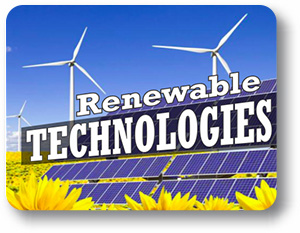
Interested in transforming energy? With concerns about climate change and growing populations’ effects on traditional energy supplies, scientists, governments, and societies are increasingly turning to renewable and innovative energy sources. In the Introduction to Renewable Technologies course, you’ll learn all about the cutting-edge field of renewable energy and the exciting new technologies that are making it possible. You’ll explore new ways of generating energy and storing that energy, from biofuels to high-capacity batteries and smart electrical grids. You’ll also learn more about the environmental and social effects of renewable technologies and examine how people’s energy decisions impact policies.
Unit 1: Introduction to Renewable Energy Technologies
How are your lights, cell phones, and water heaters powered? Every time you turn on a light or make a call, you may be using power from a limited source that emits pollutants. Or perhaps the power comes from a clean, replenishable source. In the United States, there is a 93 percent chance you are using energy from a nonrenewable energy source. Nonrenewable energy sources include coal, oil, and natural gas. Eventually they run out. Renewable energy sources come from sources that will not run out. They either replenish through a natural process or come from a source with an infinite supply. These might be sunlight, wind, rain, tides, waves, and the earth’s natural heat. In this unit, you’ll learn about renewable energy technologies and why they are important. You’ll also learn about the history of renewable energy technologies. Finally, you’ll look at some of the countries making a difference by using renewable energy.
What will you learn in this unit?
Unit 2: Climate Change & Energy Policies
You’ve probably heard of global warming. You might understand that it is a slow temperature increase all over the world. You might also know that this temperature increase somehow harms the environment. But how? In this unit, you’ll learn about global warming and how it causes climate change. You’ll also learn how climate change harms wildlife, natural resources, and humans. Consumers’ use of electricity and cars are the main causes. But changing consumer habits is not as easy as it seems. Several countries have implemented successful policies to stop global warming. By examining these success stories, we’ll look at how we can use these examples to build a framework for future climate change policies.
What will you learn in this unit?
Unit 3: The Electric Power System & Fossil Fuels
Why do we continue to use nonrenewable energy sources? We answer the question by looking at how electricity gets from Point A to Point B. The history of electricity explains how we built this system. In this unit, you’ll explore the infrastructure and history of electricity. You’ll learn about the tradeoffs in using nonrenewable sources, specifically fossil fuels, for generating power. You’ll also look at the new technologies we could use.
What will you learn in this unit?
Unit 4: Nuclear Power
If all you know about nuclear power comes from The Simpsons, you’re about to find out that there’s a whole lot more to nuclear power than what happens at the fictional Springfield nuclear power plant. Nuclear power is a chemical process of splitting atoms. It is very efficient and has the potential to power the entire world. However, it does have some disadvantages. Nuclear meltdowns can be devastating to the surrounding environment and can even cause widespread death if not managed responsibly.
What will you learn in this unit?
Unit 5: Solar Energy
Solar energy is getting a lot of attention. The sun provides lots and lots of energy, and we can use it in our homes and offices without having to use the local power company. Technologies that harness solar energy are varied and sophisticated. The sun’s heat can be used in many ways, including providing steam for traditional power plants. However, these technologies are still immature. So large-scale solar power continues to be expensive. It can also be unreliable when the sun is not shining. In this unit, you’ll learn about solar energy and the exciting ways we can use it to power our lives.
What will you learn in this unit?
Unit 6: Wind Energy
Wind energy has been around for centuries, as early as 5000 BCE. But it’s been getting a lot of attention lately as a renewable energy technology. It’s clean and sustainable, but wind turbines take up a lot of land and make a lot of noise. In addition, harnessing wind energy requires an area where the climate is optimal, and the land is preferably flat and rural. In areas with a lot of wind, this renewable technology is inexpensive and ideal, especially for homeowners who want to power their own homes. In this unit, you’ll learn more about how wind energy is created and the advantages and disadvantages of using it as an energy source.
What will you learn in this unit?
Unit 7: Biomass & Biofuels
Amongst sources of energy, biomass is the oldest. When humans first set a fire using wood, biomass energy was born. In this unit, you’ll learn about how we get electricity from biomass and biofuel. You’ll also learn about the process of converting biomass to biofuels. Finally, you’ll look at the different options for using biofuels and the pros and cons of both biomass and biofuels.
What will you learn in this unit?
Unit 8: Geothermal & Hydroelectric Energy
By now you know that energy is everywhere. And we could get it from anywhere. It’s just a matter of finding out how to convert it so we can use it for electricity. In this last unit, you’ll learn about geothermal and hydroelectric energy. Both of these renewable energy technologies use the earth’s natural energy. One uses the heat deep in the earth’s crust; the other uses the power of water.
What will you learn in this unit?
